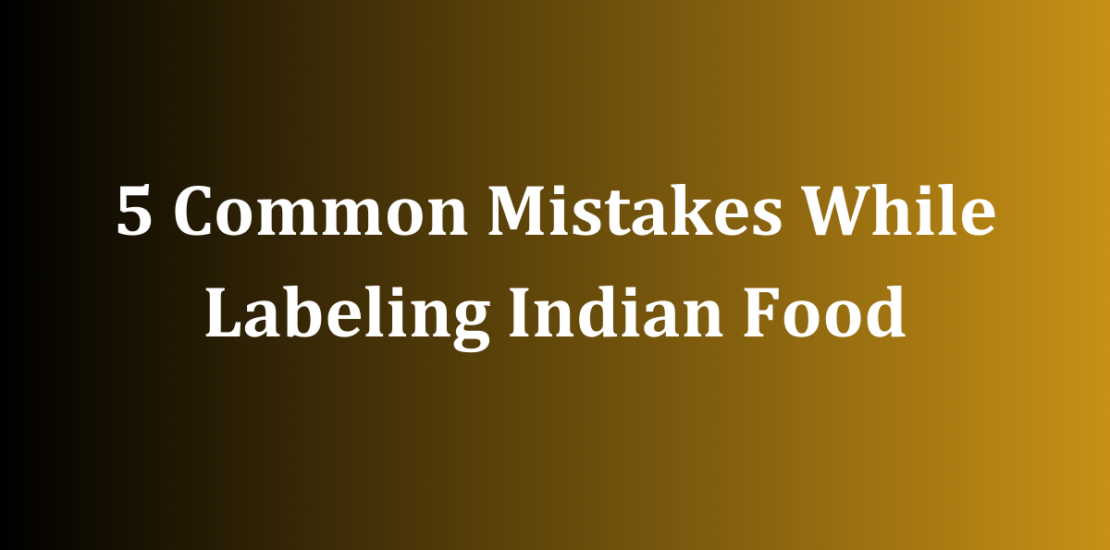5 Common Mistakes While Labeling Indian Food | Align Experts
- June 12, 2024
- Posted by: alignexperts
- Categories: Business plans, Competitive research, Innovation

Labeling food products accurately is crucial for maintaining compliance with regulatory standards, ensuring consumer safety, and building brand trust. In the diverse and dynamic landscape of the Indian food industry, labeling errors can lead to significant legal and reputational repercussions. Here are five common mistakes made while labeling Indian food, along with strategies to avoid them.
- Inaccurate Ingredient Listing
One of the most frequent mistakes in food labeling is the inaccurate listing of ingredients. This can happen in various ways:
Incomplete Lists: Omitting certain ingredients, whether intentionally or unintentionally, can mislead consumers and pose health risks, especially for those with allergies or dietary restrictions.
Incorrect Order: Ingredients should be listed in descending order by weight. Failure to do so can misrepresent the product’s composition.
Non-specific Terms: Using vague terms like “spices” instead of specifying each spice used can create confusion and mistrust.
How to Avoid:
Comprehensive Documentation: Maintain detailed records of all ingredients used in the product, including additives and processing aids.
Regular Audits: Conduct frequent internal audits to ensure that ingredient lists are complete and accurately ordered.
Transparency: Use specific terms for all ingredients to avoid ambiguity and build consumer trust.
- Misleading Health Claims
In an era where consumers are increasingly health-conscious, many food labels boast various health claims. However, making unsupported or exaggerated health claims is a common mistake that can lead to legal issues and loss of consumer trust. Examples include:
Unsubstantiated Claims: Claiming that a product can cure or prevent diseases without scientific backing.
General Health Claims: Using terms like “healthy” or “nutritious” without providing specific details or evidence.
Misleading Nutritional Information: Highlighting the presence of beneficial nutrients while downplaying or ignoring high levels of sugar, salt, or fat.
How to Avoid:
Scientific Validation: Ensure all health claims are supported by robust scientific evidence and comply with regulatory guidelines.
Clear and Specific Claims: Use precise language when making health claims and provide necessary context.
Balanced Information: Present a complete nutritional profile, highlighting both beneficial and potentially harmful components.
- Non-Compliance with Regulatory Standards
Indian food labeling is governed by the Food Safety and Standards Authority of India (FSSAI). Non-compliance with these standards can result in severe penalties, including product recalls and fines. Common regulatory mistakes include:
Incorrect Font Size: FSSAI regulations specify minimum font sizes for various information on the label.
Missing Mandatory Information: This includes manufacturing and expiry dates, nutritional information, FSSAI license number, and allergen warnings.
Incorrect Label Format: Deviating from the prescribed label format can lead to non-compliance.
How to Avoid:
FSSAI Guidelines: Familiarize yourself with the latest FSSAI labeling guidelines and ensure all aspects of your label comply.
Regular Training: Train your staff on regulatory requirements and update them on any changes.
Compliance Audits: Conduct regular compliance audits to ensure that all labels meet regulatory standards.
- Inadequate Allergen Information
With the rising prevalence of food allergies, accurate allergen labeling is critical. Common mistakes include:
Omission of Allergen Warnings: Failing to highlight the presence of common allergens such as peanuts, dairy, or gluten.
Cross-contamination Risks: Not indicating potential cross-contamination with allergens during processing.
Inconsistent Terminology: Using inconsistent or unclear terminology for allergens, which can confuse consumers.
How to Avoid:
Clear Allergen Listing: Explicitly list all allergens present in the product and use consistent terminology.
Cross-contamination Warnings: Include statements about potential cross-contamination if the product is processed in a facility handling allergens.
Regular Updates: Update allergen information regularly to reflect any changes in ingredients or processing methods.
- Cultural and Linguistic Inaccuracy
India is a country with diverse cultures and languages, and food labels need to cater to this diversity. Common cultural and linguistic labeling mistakes include:
Language Barriers: Failing to provide labels in multiple languages, especially for regional products.
Cultural Insensitivity: Using imagery, names, or descriptions that could be culturally insensitive or offensive.
Misrepresentation of Cultural Foods: Incorrectly labeling or describing traditional foods, leading to consumer mistrust and cultural appropriation accusations.
How to Avoid:
Multilingual Labels: Provide labels in multiple languages relevant to your target market, ensuring clear communication.
Cultural Sensitivity Training: Educate your team about cultural sensitivities and ensure that all labeling respects cultural norms and traditions.
Accurate Descriptions: Ensure that descriptions of traditional foods are accurate and respectful, reflecting their true cultural significance.
Conclusion
Accurate food labeling is essential for compliance with regulations, ensuring consumer safety, and maintaining brand trust. By avoiding common mistakes such as inaccurate ingredient listing, misleading health claims, non-compliance with regulatory standards, inadequate allergen information, and cultural and linguistic inaccuracies, you can enhance the reliability and credibility of your food products. Here are some final steps to help ensure your food labeling is accurate and effective:
Regular Training and Education
Keeping your team well-informed about the latest labeling requirements and best practices is crucial. Regular training sessions and workshops can help your staff stay updated on regulatory changes and industry trends.
Utilizing Technology
Leverage technology to streamline your labeling process. Labeling software can help ensure compliance with regulations, automate updates, and reduce human error.
Consumer Feedback
Listening to consumer feedback can provide valuable insights into how your labels are perceived and understood. Encourage customers to share their experiences and suggestions for improvement.
Consulting Experts
Consulting with legal and industry experts can help you navigate complex labeling regulations and avoid potential pitfalls. An expert can provide tailored advice to ensure your labels meet all necessary standards.
By implementing these strategies, you can protect your brand, comply with regulations, and provide your customers with clear, accurate, and trustworthy information about your food products.
Leave a Reply Cancel reply
Contact us at the Consulting WP office nearest to you or submit a business inquiry online.

